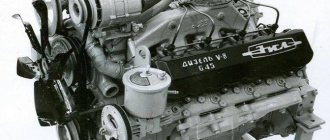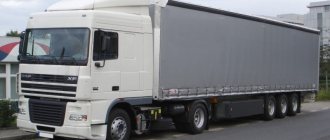The FAW 1041 truck has been produced by a Chinese company since 2008, and in 2009, models began to be assembled in Biysk. It is characterized by medium dimensions and can be equipped with several chassis options - standard, extended and with a sleeper.
The advantages include the ability to control drivers with driving category “B”. Its mass is 3.5 tons, such a car can be moved around the city center. Compactness and maneuverability provide the ability to move along narrow streets. The FAW 1041 truck is equipped with a heating system, ABS, fog lights, power steering, a car radio and a fuel filter with a heater in a standard assembly.
The main area of application is cargo transportation. The advantages that determined the popularity of the machine include efficiency, high quality and maneuverability. To ensure efficiency, the manufacturer has provided the ability to transport cargo weighing up to 2 tons. The FAV 1041 truck is characterized by spaciousness and comfort, it is suitable for transporting cargo within the city and between populated areas. It consumes a small amount of fuel and does not require frequent maintenance.
Specifications
Dimensional characteristics of FAW 1041:
- length – 5253 mm;
- width – 1900 mm;
- height – 1900 mm;
- wheelbase – 2850 mm.
The ground clearance of the model is 180 mm. In this case, the truck can turn around at a distance of 8 m. The front track is 1390 mm, the rear track is 1414 mm.
With a total weight of 3500 kg, the model has a load capacity of 2000 kg. The front axle weighs 1520 kg, the rear axle – 2530 kg. The car is capable of reaching speeds of 110 km/h. Braking distance when accelerating to 60 km/h is 36.7 m
Engine and transmission
The heart of the car is a 4-cylinder in-line diesel engine. Its displacement is 3.17 liters, power is 90 hp. The upper limit of torque of 245 Nm is reached already at 1900 rpm, when the maximum number of rotations per minute is 3200 rpm.
The power plant is equipped with turbocharging and a liquid cooling system. The latter requires a separate word, because it was executed very successfully. Its wide flow channels prevent the motor from overheating and allow it to be operated at its maximum without any consequences.
The force from the engine is transmitted to the rear axle by a 5-speed synchronized manual transmission of the CAS5 model. It is equipped with a single-plate dry clutch with hydraulic drive.
Brake system
The FAV 1041 truck is equipped with a dual-circuit brake system with hydraulic drive and a vacuum booster. Drum units are installed on both bridges. The cable-driven “handbrake” works in conjunction with the transmission.
Fuel consumption
One of the key indicators for commercial vehicles is fuel consumption. The model is equipped with a fairly large tank for fuel. Its volume is about 100 liters, which, with a consumption of 12 liters per 100 km, allows the car to be used for long trips.
However, it should be taken into account that such indicators are indicative and are valid when the car is moving at a speed of 60-80 km/h. When heavily loaded or traveling too fast, the truck may consume slightly more fuel, which should be kept in mind when planning your route.
Ride quality
- cruising speed at which the lowest fuel consumption occurs is 80 km/h;
- maximum speed - 110 km/h;
- permitted elevation angle - 28;
- average braking speed - more than 5;
- braking distance at a speed of 60 km/h - 36.7 meters;
- R16 tires.
Driving performance is also improved by the fact that the engine blocks have wide flow channels for coolant, and therefore it is almost impossible to overheat.
On restyled models, an ABS anti-lock braking system is installed, and power steering makes life easier for the driver. The existing fuel filter is equipped with a heater and a water separator. The latest models (after 2011) have an improved, more powerful interior heater.
There is a receiver with MP-3, speakers, antenna, USB.
Operating experience of this vehicle suggests that with proper care of it and its components, the service life before major repairs is 250-300 thousand kilometers on Russian roads.
Original parts last four times longer than similar Russian spare parts.
We clean car injectors ourselves.
Chinese cars always arouse my keen interest. With cars from well-known and renowned brands, you often know in advance what to expect. But with the “Chinese” it’s a completely different matter; they are always different in both design and workmanship. Therefore, every new Chinese car becomes a discovery!
My affectionate and gentle... Delivery van FAW 6371 in the photographs looks larger than it actually is. This effect probably happens because the proportions of the car are chosen very well, and the half-hood layout gives the car a bit of solidity. But this car is very small, almost toy-like and at the same time cute and friendly. He just wants to give him some kind of diminutive name. To imagine the true dimensions of the FAW 6371, the following analogies can be given: in length it is comparable to the Tavria passenger car, in width to the Oka car, and in height to the Izhevsk “heel”. The internal volume of the cargo compartment on the FAW is more than three “cubes”, and the carrying capacity of the machine is 520 kg. The small external dimensions of the car, the large internal volume of the all-metal body and decent load capacity are the most important advantages of the “Chinese car”. After all, our most common vans based on passenger cars with a pickup body, having comparable load capacity and body volume, can rarely boast such small external dimensions. In cramped conditions, but not offended
Wanting to highlight the identified advantages of the FAW 6371 with the help of photographs, we were so carried away that we began to drive it into such narrow places that were not intended for vehicle traffic: narrow pedestrian paths and warehouse landing stages, where before FAW only hand trucks ruled. At the same time, our car did not have any problems with maneuverability and visibility - due to the large angle of rotation of the front wheels, it fit perfectly into narrow passages, and when moving the car back, a large window in the rear door helped to control the situation from behind.
Tall people need to protect their heads when getting into the cab. Maneuvering in narrow passages, we at the same time appreciated another important advantage of this car: three doors lead into its cargo compartment at once: two side sliding ones on different sides and one rear lifting one. And in order to load and unload a van, you don’t have to think about which side is more convenient to approach the loading place. Anyone can! And the sliding side doors allow you to drive almost close to the loading area. The loading height of the cargo compartment was also pleasing: 560 mm, which corresponds to the loading height of the trunk of a modern passenger car. From the above we can conclude: the FAW 6371 vehicle is perfectly suited for driving, maneuvering and loading and unloading operations in particularly narrow and cramped spaces. By the way, the central streets of megacities have long become “narrow spaces”, so those who, due to the nature of their commercial activities, have to transport small consignments of goods or carry out small courier deliveries in crowded streets or in the streets of ancient cities with dense buildings should take a close look at this car. .
Inside
After a lot of spinning around in the cramped space, we decided to explore what was inside this baby. But, having opened the hood at the front of the car, they found only the radiator of the cooling system and necks for refilling process fluids. Where's the engine? It turned out that the power unit itself is located in the base of the car, under the seats of the driver and his only passenger. There is nothing surprising in this arrangement - this solution is often used on Asian cars, especially Japanese ones, but such cars most often have a cabover layout, rather than a half-hood, as in our case.
The back of the seats protrudes somewhat into the cargo compartment and folds out well to serve as a berth, but when folded it will not allow you to transport long items. To get to the engine in the FAW 6371, you need to unclip the locking clips under the seats and fold them back into the cargo compartment. This is where the first problems appear. If there is a load in the body, and, as a rule, they try to place it closer to the beginning of the body, so that during sharp braking it moves forward as little as possible, then it is no longer possible to recline the seats without shifting this load back. The reclining seats make it impossible to install a partition in the van. This means that in case of danger, the crew of the vehicle is not protected in any way from the movement of cargo in the body (in the event of an accident, the cargo from the body can move into the cabin). But the worst thing will happen in the cold season: any, even short-term opening of the body doors for loading and unloading operations will immediately freeze the entire internal volume of the car, including the cabin. In order for the FAW 6371 to be able to operate normally in Russian winter conditions, in my opinion, it is necessary to install a solid, heat-insulated partition in the car, and the issue of access to the engine should be resolved in another way, for example, by making the driver and passenger seats removable. By the way, in order to service the Chinese car’s engine, you don’t always need to crawl under the seats. Many car components are completely accessible for maintenance and repair from below the car. For example, the engine starter is accessible only from below, but to get to it you will need an overpass or a repair ditch. Behind the wheel
Despite my height (182 cm), I sat quite comfortably in the cabin of the Chinese microvan. The almost vertical driving position and the high roof of the van help. But there is not enough space on the sides, but this is a price to pay for the small width of the car. But everything is at hand, you don’t have to reach for anything specially. The gear lever is in a convenient location, but the shifts themselves are accompanied by a quiet clunking sound. But if it clangs, you can be sure that the gear has engaged properly; if not, the attempt to engage must be repeated.
Rear-view mirrors provide good visibility of the surroundings. The interior decoration of the FAW 6371 cabin is made in a modern style, without traditional Chinese frills (a wood-like dashboard finish or a leather-trimmed steering wheel). The plastic gray dashboard combined with black inserts looks quite European here. The quality of the cheap plastic is alarming, but not disappointing; it doesn’t feel slippery or brittle to the touch, it’s just secured in some places with open screws, and in some places it has sharp, unprocessed edges.
The instrument cluster is made in the best traditions of the world automotive industry - large round gray scales of the speedometer and tachometer (the car has a tachometer!) in silver rims are located in the center and their readings are easy to read while driving. Similarly designed small scales on the sides inform about the coolant temperature and fuel level. Under the small scales there are blocks of signal lamps. This combination of instruments is pleasing to the eye and easy to use.
The interior door trim is molded plastic (darker than the dash) with fabric inserts and comfortable armrests. The seats in the car are a bit stiff, but have a wide range of adjustment for backrest tilt and longitudinal movement. But I didn’t like the fabric trim - it’s thin and slippery, which makes it difficult to take a certain position on the seat, you always slide somewhere. True, this upholstery deficiency can be easily eliminated by covering them with universal passenger car covers. The standard equipment of the cabin includes a cheap Chinese radio, which can only be heard when the car is stationary. While driving, the sound of weak speakers installed in the rear of the car mixes with the noise of the car itself and develops into a cacophony of sounds, which is very annoying. The owner, of course, will have to change the radio, and at the same time rearrange the speakers.
Rear cargo door with large rear view glass. Pay attention to the additional brake light mounted above the rear window, and the floor of the car body is lined with special linoleum with neat edging. Let's go!
Vibration and poor sound insulation of engines is a “family trait” of all Chinese trucks. The FAW 6371 van is a pleasant exception in this regard, probably because it has a gasoline engine rather than a diesel one. At idle speed this engine is almost inaudible, but while driving the empty body in the same volume as the cabin resonates so much that any sound in a moving car is amplified many times over. With such a soundtrack, the noise from the engine is far from the loudest.
The car accelerates confidently to 100 km/h, and the power of a small engine is quite enough here. The technical specifications state that 100 km/h is its maximum speed, but in reality, albeit slowly and reluctantly, the car continues to accelerate further. On a completely flat dyno road at the test site, we managed to reach a speed of 114.8 km/h. At the same time, the needle on the car’s speedometer showed 120 km/h.
In general, the FAW 6371 handles at the same level as a regular small passenger car and behaves quite confidently when cornering or when shifting. But one day, while turning a corner at a speed of about 60 km/h, the empty car jumped onto an uneven section of the road. And then the rear axle lost contact with the asphalt and literally slid to the side. The car did not lose control or skid, but this phenomenon is very alarming. Apparently, when empty, even despite the actual placement of the power unit within the base, the rear axle of the FAW 6371 remains underloaded and easily goes into a skid as soon as the close contact of the wheels with the road is broken. The rigid spring suspension of the rear axle also plays an important role in this behavior of the car.
Fuel consumption on an empty and loaded van is almost the same and, based on our measurements, averages 7.7 liters per 100 km (according to the manufacturer 6 l/100 km). In city driving with a fully loaded vehicle, fuel consumption can increase to 9 liters, which is very good for a van carrying half a ton of payload.
There are only filler necks under the hood. Let's sum it up
After testing, the FAW 6371 van left more positive impressions than negative ones. This doesn’t happen often with the “Chinese” yet. Moreover, this is probably the first Chinese truck with which there were no technical problems during the tests and during the tests nothing broke, warped or fell off.
It is clear what consumer niche this car is aimed at at a price of $7990 - it enters into direct competition with domestic vans based on passenger cars. Moreover, in terms of the totality of consumer properties, the Chinese car is clearly ahead of them. The manufacturer’s warranty also helps the “Chinese” in competition: for FAW 6371 it is 3 years or 60,000 km. But for widespread consumer recognition of the positive qualities of the Chinese van, there is still not enough clear and widespread service for cars from the Middle Kingdom and an uninterrupted supply of spare parts.
Special opinion
The impressions of working with automotive equipment made in China are perhaps akin to visiting a restaurant serving Chinese national cuisine. Exoticism and ignorance; what ingredients are used, what recipe is used to prepare this or that dish, how and with what it can be consumed, and whether the resulting impressions will be justified by the cost of visiting the establishment. In the model range of FAW cars presented on the Russian market, a “new dish” appeared in November 2006, which we were able to taste before the start of official sales.
You can get to the engine by folding down the seats in the cabin. This is an all-metal van FAW CA6371 with a load capacity of 520 kg with the possibility of three-way loading, with an engine displacement of just over one liter and an engine power of 52 hp. Car manufacturing technology raises questions. The upper portions of the side panels and sliding doors were clearly intended to be glazed, as was the rear door, but the finished openings were then sealed with metal inserts using conventional rivets and sealant.
Sliding doors do not have external locking cylinders, but only internal locking buttons. It seems strange for such a miniature cargo compartment to have upper handrails and handles for closing the side doors from the inside. The interior upholstery with built-in speakers also looks like remnants of its former luxury. The reconstruction of the front end of the vehicle compared to its predecessor FAW 6350 CargoVan has dramatically changed the entire appearance. The front axle moved forward outside the driver’s cabin gave it the appearance of a “bulldog jaw”, and the full doorway gave it solidity. The taste of the new dish is most reminiscent of the already disappeared AZLK-2140 with the taste of a natural “penny”, with the exception of excellent maneuverability in a limited space. It turned out to be quite bland in terms of engine power and fuel and speed indicators. If we compare the fuel consumption values obtained during editorial tests of the FAW CA6371 vehicle with the results of inspection tests in 2001 of the IZH-2717-220 van for compliance with the fuel consumption specifications at control points of 60 and 90 km/h, then we can say that they are completely identical. The car, especially in the passenger version, could adequately fill the disappearing price niche of cars on the Russian market from the Oka to the Zhiguli “classic”, especially since it is equipped with a neutralization system and complies with Euro 2 standards already adopted in Russia. The main thing is that its price more realistically reflects consumer qualities.
The engine is located under the driver and passenger seats. It had to be limited in height, strongly tilted towards the left side of the car. In this case, it should be about 160 thousand rubles, and only on the condition that a talented Russian car enthusiast, a potential client of such a niche, independently and quickly solves the problem of anti-corrosion treatment of the bottom and engine protection from dirt and mechanical damage. The proposed minimum price for the basic configuration of 215 thousand rubles will be able to curb the appetite of even the most picky gourmet.
In the FAW family of microtrucks, in addition to the all-metal van, there are two other modifications - the FAW CA1020V car with a double cab and a metal platform with three folding sides with a load capacity of 930 kg and the FAW CA1020VR pickup truck with a two-row five-seater cab and a metal side platform with a load capacity of 825 kg. Both cars are slightly longer than the van (wheelbase 2550 mm versus 2450 mm) and are equipped with a less powerful engine (48 hp).
Device
The driver's cabin does not have a hood, which makes it possible to significantly reduce the dimensions of the vehicle. This feature is extremely useful when driving in urban environments, where there is a shortage of free space. The 1041 model can be produced in various body variations - flatbed, tilt or isothermal van, as well as non-standard modifications.
Such diversity allows the car to be used for a variety of tasks, which has contributed to its spread. In addition, provided that the body is chosen correctly, a truck can be used to transport products with a limited shelf life.
The design of the car has not only advantages, but also disadvantages. In particular, many owners note the relatively poor build quality of some components, where cracks, gaps and other unfinished elements can be observed.
Experienced owners of cars from this manufacturer recommend insulating the cabin by sealing the cracks under the doors, and also closing the fuel filter, battery and sump. After such manipulations, the structure will be ready for operation in the harsh climatic conditions typical of the Russian Federation.
Driver's cabin
The FAV 1041 cabin is made of a single sheet of steel, its design does not have a hood, and a convenient mechanism is provided for tilting. Ease of access to the cabin is due to the installation of wide doors, and safety of operation is due to large windows and rear-view mirrors.
The instrument panel is upholstered in wood-plastic, and the steering wheel is covered in leather. It is informative and easy to understand; even a beginner can read the data. Driving the car is quite simple; the interior space is designed for two people. The steering column and seats can be adjusted in several planes. The kit comes with seat belts.
There is a cigarette lighter in the interior of the FAW 1041 truck. The pedals are located taking into account ergonomics and convenience, the accelerator can be adjusted to the individual characteristics of the driver. The fuel supply is carried out smoothly, which eliminates jerks when moving and maintains the required speed limit.
Modifications
On the domestic market, FAW CA 1041 is presented in three versions:
- The L-3 has a standard all-metal cab with two seats for the driver and passenger;
- L2-3 has an extended base for transporting large cargo;
- In addition to the extended base, the L2R5-3 has an unusual cabin - it is equipped with a berth, which makes it suitable for long trips.
New FAW wins Truck of the Year in China
And again news from a separate planet - from China. The tractor of the leader of the local automobile market, the FAW company, won the “Truck of 2022” competition, also Chinese.
The local jury does not have any difficulties with selecting participants, unlike, say, the European one. After all, in China there are more than two dozen large truck manufacturers alone. And the scale of production is truly amazing. For example, according to local data, sales of exclusively heavy trucks in the first half of this year amounted to 749 thousand units. The Chinese really want local brands to take part in the European Truck of the Year competition, the oldest and most authoritative. But for now the prize is awarded specifically to the “Chinese truck of the year”: however, the competition is held under the auspices of the international Truck of the Year competition (in which Russia is traditionally represented by Fedor Lapshin), but in reality this only means that the local jury cooperates with the European one on various issues , and no more.
Three candidates from well-known and well-known brands reached the finals of the 2019 competition: CAMC, Foton and FAW. The last one won. The winner of the competition, the FAW J7 Eagle, is said to demonstrate the best that cargo engineering from China can now offer. Interestingly, the letter J in its designation is a reference to the name of the first truck of the brand, the Jiefang CA-10 model (a copy of our ZiS-150). But still, some points in the newcomer’s description are alarming.
For example, judging by the photo, the completely new cabin interior is not inferior to any Chinese competitor, although it is still specific for Europeans: the plastic is rough, there is a large window on the rear wall, and between the seats there is an archaic “poker” of the gearbox. The declared noise level is only 53 dB. However, why is the tractor declared a three-seater with the usual two seats?
Its own diesel engine with a volume of 12.5 liters develops a power of 550 hp, and its promised resource is as much as 1.2 million kilometers.
It is also strange that the declared total weight of the road train is only 40 tons. This is in China, on a three-axle tractor with an axle load capacity of 7+18 tons and with such power?
Jiefang CA-10 - the first Chinese truck, a copy of the Soviet ZiS-150
Either these are all advertising statements, or the Chinese have moved to a qualitatively different level of production. And the residents of our country, unlike Europeans, have a chance to find out this in a couple of years - however, with the traditional Chinese three-axle layout, the car is unlikely to be popular with us. And “Chinese” two-axle tractors are almost never sold in Russia...











